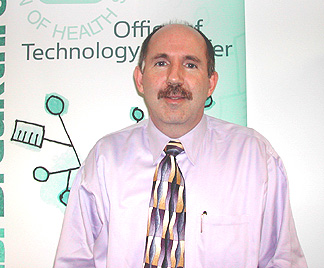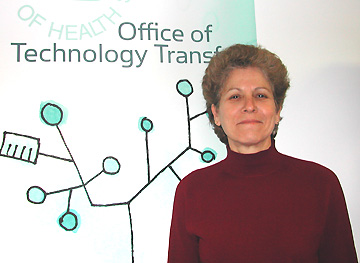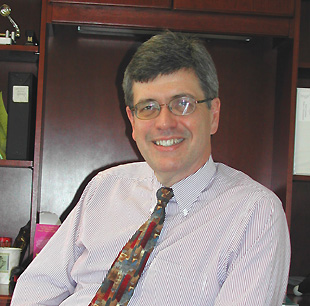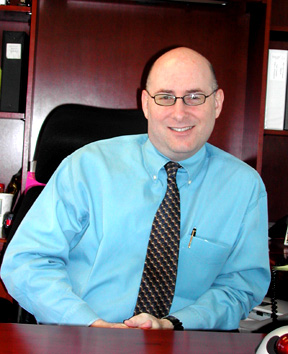| T
H E N I H C A T A L
Y S T |
M
A Y – J U
N E 2005 |
|
FROM
BENCH TO TECH TRANSFER
AND BACK TO THE NIH SCIENTIST
|
by Fran
Pollner
|
 |
Mark
Rohrbaugh
"The
conflict-of-interest issue certainly should not decrease the number
of formal collaborations between NIH scientists and industry. The new
policy in no way limits such activities as part of one’s official
duties. Scientists are encouraged to establish such links, select CRADA
partners based on their knowledge and working relationships with them.
. . . Licensing is another story. The scientists are not involved. They
can’t make requests on behalf of a company. We keep a wall between
them and the financial terms of a license related to what they’re
doing in the lab."
|
There
is a firewall between NIH scientists and the financial end of NIH tech transfer,
says the director of the NIH Office of Technology
Transfer.
In all matters scientific,
however, OTT Director Mark
Rohrbaugh emphasizes, NIH researchers are the heart of tech transfer—from
the point of discovery through the successful introduction of a new therapy
into clinical practice.
There’s a growing
awareness among NIH researchers of the mission of OTT, which is to disseminate
to the world at large the discoveries made in NIH labs. These include research
tools for the greater research community and vaccines, drugs, devices, and techniques
with clinical application for the bedside, wherever they are needed.
The tools of tech transfer
in NIH’s repertoire include CRADAs (cooperative research and development
agreements) and material transfer agreements, managed at the institute/center
level, and—managed by OTT—patenting of NIH inventions and licensing
them to commercial entities that can bring them to market in the United States
and/or abroad.
Not all new "art"
needs or warrants patenting, observes OTT Deputy Director Bonny
Harbinger, but a patent secures intellectual property rights for NIH, may
generate royalties, and becomes a tool for securing favorable terms in licensing
negotiations—terms typically aimed at maximizing access to an invention
that meets a public health need.
 |
Bonny
Harbinger
"We
have one of the largest tech transfer programs, and we are inundated
with requests for training. We now have visitors from Ireland and China—for
six months of training, and two groups are coming from India and Hungary.
This [interaction] provides us with contacts in these countries to help
us place licenses and gives us the opportunity to teach others the way
we think tech transfer should be conducted to provide the greatest public
health benefit—which is critical to us."
|
It
Takes a Scientist
The road to a patent,
Harbinger emphasizes, begins with an NIH researcher’s recognizing that
he or she has come up with something unique and useful—and, consequently,
filing an "employee invention report," or EIR, with the institute’s
technology development coordinator. If a researcher doesn’t know whether
an EIR is warranted, the coordinator or OTT is always on hand to offer advice.
There were more than 400
EIRs submitted to OTT in 2004, compared with 268 in 1997; OTT sought patents
for 199 of these. It’s helpful, Harbinger notes, if researchers file their
invention reports several months before they anticipate public disclosure of
the research—to allow time for OTT and the ICs to review the invention
report and OTT’s contract law firms to apply for a patent should that be
desirable.
Many NIH inventions, says
Steve Ferguson,
director of the OTT Division of Technology Development and Transfer, emerge
from career scientists looking at basic mechanisms—"when suddenly
there’s a breakthrough observation—often when something has gone terribly
wrong."
That "darkest before
the dawn" insight has been described by NIH inventors who have participated
in the Research Festival "Eureka!" minisymposium, organized by Ferguson
as a way to recognize the genius of NIH scientist-inventors.
The Eureka! session, says
Brian Stanton,
the new director of the OTT Division of Policy, also highlights the "fundamental
value of scientists in the lab just playing around, so to speak." This
freedom is unique to NIH, Stanton says, and—something Congress may not
realize—it’s essential to the success of the NIH tech transfer program.
In interviews with The
NIH Catalyst, Rohrbaugh, Harbinger, Ferguson, and Stanton discussed what
they characterized as the very healthy state of NIH tech transfer. The OTT has
undergone reorganization and expansion, has become a training ground for scientists
interested in tech transfer, hosts visiting scientists from around the world,
and is involved in international groups that formulate global tech transfer
policies.
The office set a record
last year in the licensing arena, concluding 276 licenses—one for each
business day, Ferguson noted—including 32 new and amended licenses with
foreign countries.
 |
Steve
Ferguson
"At
NIH, very often competing treatments for the same disease are being
funded or researched. It’s a mutual fund philosophy: You may not
know which approach will work, but you know that something will. And
whatever works, the public benefits. Here’s an example: NIH was
involved in the development of a drug for AIDS-related cytomegalovirus;
it was the first of its class—an antisense drug for CMV. And we
were also involved in the development of anti-HIV cocktails that have
preempted CMV eye infections. So we have a novel wonder drug that makes
no money for the company or for NIH. Overall, it’s a success story
because we are a public health agency, but that may not be so for the
company that did the clinical trials—they got proof of principle,
but not return on investment."
|
The
International Arena
Part of the OTT emphasis
on licensing, says Rohrbaugh, is to facilitate access in developing countries
to NIH technologies that meet public health needs. "One person now works
full time in that area, developing ties and identifying institutions—companies,
government entities—interested in and capable of bringing needed products
to market," he said, referring to the new position of senior advisor for
international tech transfer, filled by Luis
Salicrup.
Licensing and discussions
in developing countries were particularly successful last year, he said, and
aimed at facilitating the production at lower cost of needed drugs and vaccines,
especially for infectious and tropical diseases—rotavirus, dengue, malaria,
tuberculosis, HIV, and meningitis—as well as cancer and diabetes.
Once OTT negotiates a
license with a company that will move an NIH invention out of the lab, the NIH
inventors can be involved in the continuing development of the product and are
encouraged to discuss scientific questions about the technology as part of their
official duties. They can advise a prospective licensee on such matters as how
best to grow cells, interpret data, or design a clinical trial. They cannot
advise on such matters as royalties or other financial terms of the licensing
agreemen—or advocate on behalf of a particular company.
 |
Brian
Stanton
"How
does NIH define a return on investment, a tech transfer success? Is
it in dollars? In the number of licenses negotiated? Or is it in benefit
to the public health? OTT has many customers: there’s the public
at large, our scientists, the institutes, and the companies that are
our partners. There are ways to preserve commercialization of a product
with an exclusive license—and still break down the component parts
of the technology to be licensed. We can negotiate separate agreements
with the company so that researchers still have easy access to the antibodies,
the reagents, the pieces of DNA, while the company has exclusive rights
to market the downstream product."
|
Balancing
Acts
Many interests must be
balanced in the process of licensing, Ferguson noted. "Being a catalyst
for research is an NIH mission, and we have to be careful that licensing doesn’t
get in the way of that," he said. Some of the language in negotiated agreements
stipulates that NIH and others will retain the rights to do research related
to the license.
If a company balks, that
can become a point of negotiation, he said, with NIH perhaps compromising with
terms more favorable to the company in exchange for broader dissemination of
the technology. In such a case, the financial goal takes a back seat to the
goal of advancing research.
Deciding to place as much
as possible of the Human Genome Project
into the public domain is an example of putting public interest first, Stanton
said. "This was a conscious choice not to patent and to license nonexclusively.
But OTT also has an obligation
to NIH scientists and institutes, Stanton noted.
"There is an expectation
that we will receive a reasonable return for technologies we license,"
he said. "We want to give something back to our inventors—and to the
institutes so they can do additional research."
Returns
of the Days and Decades
There is no question that
NIH inventions generate income. The payments to NIH negotiated in exchange for
licensing rights have been increasing year by year as the portfolio swells with
new inventions and continuing returns on old ones.
At a meeting of the Scientific
Directors in February, Rohrbaugh reported that there were about 2,300 issued
or pending patents and 1,650 active licenses that in 2004 generated over $56
million in royalties, $9 million of which went to the inventors.
At NIH, the royalties
are apportioned such that the first $2,000 in royalties is shared among the
inventors; above that up to $50,000, 15 percent goes to the inventors and the
rest to their institutes; above $50,000, 25 percent goes to the inventors and
75 percent to the institutes. An inventor can receive up to $150,000 a year,
every year. "And wherever the inventor may be, we send out the royalties—and
beyond that, the royalties will go to his or her estate," Harbinger noted.
Last year, Rohrbaugh added, about 400 former and current NIH researchers were
paid royalties.
Many of the inventions
that generated the most in royalties in 2004 have been around for more than
a decade (see "top 20" list below).
Rohrbaugh noted that nowadays,
among inventions likely to interest prospective corporate partners are those
that combine technologies, such as the cardiovascular stent that releases a
known anticancer drug that interferes with cell proliferation, thereby reducing
the incidence of restenosis after coronary angioplasty. This invention was one
of three new OTT-licensed technologies that gained FDA approval in 2004 and
was also one of the 20 that generated the most royalty income for NIH in 2004
(see "top 20" and "2004
approvals" below).
"Personalized medicine,
such as cancer therapies and diagnostic techniques—tailored to the susceptibility
of your cancer—is another growing area of interest," Harbinger added.
"Instead of throwing spaghetti on the wall and seeing what sticks, you
determine in advance what will stick," she said.
Since April 2005, OTT
has listed as available for licensing more than 40 new technologies. 
|
Some
Stats for FY 2004
(covering NIH and FDA)
|
| Invention
Disclosure Reports |
403 |
| New
U.S. Patent Applications Filed |
199 |
| Issued
Patents |
122 |
| Executed
Licenses |
276 |
| Royalties
(in millions) |
$56.3 |
| Executed
CRADAs (NIH only) |
87 |
Standard
|
43 |
Material
|
44 |
|
OTT-Licensed
Products Approved by FDA in FY 2004
|
|
Between 1991
and 2004, FDA approved 23 products based on technologies developed in
the NIH Intramural Research Program. The three 2004 newcomers were:
 Paclitaxel-eluting coronary stent system to inhibit restenosis after coronary
angioplasty (James Kinsella et al., NIA)
Paclitaxel-eluting coronary stent system to inhibit restenosis after coronary
angioplasty (James Kinsella et al., NIA)
 Generic form of didanosine (ddI) delayed-release capsules in the treatment
of HIV infection (Hiroaki Mitsuya et al., NCI)
Generic form of didanosine (ddI) delayed-release capsules in the treatment
of HIV infection (Hiroaki Mitsuya et al., NCI)
 Recombinant human keratinocyte growth factor protein, the first and only
therapy for the severe mouth sores accompanying myelotoxic therapy for
hematologic cancer (Jeffrey Rubin et al., NCI)
Recombinant human keratinocyte growth factor protein, the first and only
therapy for the severe mouth sores accompanying myelotoxic therapy for
hematologic cancer (Jeffrey Rubin et al., NCI)
|
|
Top
20 Inventions in Royalties, 2004
(year
refers to FDA approval or date of introduction)
|
|
Vaccines
and Therapeutics
 Monoclonal antibody to treat respiratory syncytial virus–the first
MoAB licensed by the FDA to treat any infectious disease (1998, Brian
Murphy et al., NIAID)
Monoclonal antibody to treat respiratory syncytial virus–the first
MoAB licensed by the FDA to treat any infectious disease (1998, Brian
Murphy et al., NIAID)
 Didanosine (ddI), reverse transcriptase inhibitor that interferes with
HIV replication (1991, Hiroaki Mitsuya et al., NCI)
Didanosine (ddI), reverse transcriptase inhibitor that interferes with
HIV replication (1991, Hiroaki Mitsuya et al., NCI)
 Paclitaxel as a cancer treatment (1992, Wyndham Wilson et al., NCI)
Paclitaxel as a cancer treatment (1992, Wyndham Wilson et al., NCI)
 Proteosome inhibitor to treat multiple myeloma–the first of its class
approved by FDA (2003, Shanker Gupta, NCI)
Proteosome inhibitor to treat multiple myeloma–the first of its class
approved by FDA (2003, Shanker Gupta, NCI)
 Synthetic thyrotropin as adjuvant in thyroid cancer (1998, Fredric Wondisford
et al., NIDDK)
Synthetic thyrotropin as adjuvant in thyroid cancer (1998, Fredric Wondisford
et al., NIDDK)
 Nutritional supplement to treat macular degeneration (2003, Rick Ferris
et al., NEI)
Nutritional supplement to treat macular degeneration (2003, Rick Ferris
et al., NEI)
 Hepatitis A vaccine (strain HM-175) (1995, Richard Daemer et al. and Ann
Funkhouser et al., NIAID)
Hepatitis A vaccine (strain HM-175) (1995, Richard Daemer et al. and Ann
Funkhouser et al., NIAID)
 Radioimmunotherapy for non-Hodgkins lymphoma–the first such product
approved by the FDA (2002, Otto Gansow, NCI)
Radioimmunotherapy for non-Hodgkins lymphoma–the first such product
approved by the FDA (2002, Otto Gansow, NCI)
 Dideoxycytidine (ddC), reverse transcriptase inhibitor that interferes
with HIV replication (1992, Hiroaki Mitsuya et al., NCI)
Dideoxycytidine (ddC), reverse transcriptase inhibitor that interferes
with HIV replication (1992, Hiroaki Mitsuya et al., NCI)
Diagnostics
 Serological detection of antibodies to HIV-1 (1985, Robert Gallo et al.,
NCI; Luc Montagnier et al., Pasteur Institute)
Serological detection of antibodies to HIV-1 (1985, Robert Gallo et al.,
NCI; Luc Montagnier et al., Pasteur Institute)
 DNA probe for breast cancer diagnosis (2001, Charles Richter King et al.,
NCI)
DNA probe for breast cancer diagnosis (2001, Charles Richter King et al.,
NCI)
 Genotyping of HIV protease gene (1996, Stephen Oroszlan et al., NCI)
Genotyping of HIV protease gene (1996, Stephen Oroszlan et al., NCI)
 Serological detection of antibodies to HTLV-1 (1985, Takis Papas et al.,
NCI)
Serological detection of antibodies to HTLV-1 (1985, Takis Papas et al.,
NCI)
Instrumentation
and Devices
 Paclitaxel-eluting coronary stent system to inhibit restenosis after coronary
angioplasty (2004, James Kinsella et al., NIA)
Paclitaxel-eluting coronary stent system to inhibit restenosis after coronary
angioplasty (2004, James Kinsella et al., NIA)
 Enhanced magnetic resonance imaging through magnetization transfer (1998,
Robert Balaban et al., NHLBI)
Enhanced magnetic resonance imaging through magnetization transfer (1998,
Robert Balaban et al., NHLBI)
 Laser capture microdissection (1997, Lance Liotta et al., NCI)
Laser capture microdissection (1997, Lance Liotta et al., NCI)
Research
Materials
 Reconstituted basement membrane (1993, Hynda Kleinman et al., NIDCR)
Reconstituted basement membrane (1993, Hynda Kleinman et al., NIDCR)
 Recombinant cytochrome P-450 (1993, Harry Gelboin et al., NCI)
Recombinant cytochrome P-450 (1993, Harry Gelboin et al., NCI)
 Transforming growth factor-b (2002, Michael Sporn et al., NCI)
Transforming growth factor-b (2002, Michael Sporn et al., NCI)
 Anthrax protective antigen (2002, Stephen Leppla, NIDCR)
Anthrax protective antigen (2002, Stephen Leppla, NIDCR)
|
Return to Table of Contents


